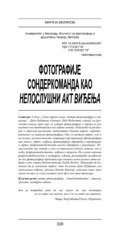Фотографије Сондеркоманда као непослушни акт виђења
Sonderkommando Photographs аs A Disobedient Act Of Seeing
Чланак у часопису (Објављена верзија)
Метаподаци
Приказ свих података о документуАпстракт
У делу Слике упркос свему: четири фотографије из Аушвица, Диди-Хуберман (Georges Didi-Huberman) указује на различите начине кроз које су четири фотографије о којима је реч настале као противтежа или упркос нечему. Покушаћу да раздвојим и објасним различите модалитете бивања упркос, карактеристичне за наведене фотографије. Оне су настале упркос, али и на основу, незамисливости ситуације коју приказују (фотографија као доказ), упркос забрани фотографија (препрека у продукцији) и упркос репрезентабилности човека (препрека у рецепцији). Назмисливост нас доводи у везу са појмовима доказа, истине, али и моћи, репрезентабилности, забране и правила. На основу појмова репрезентабилности и културног сећања, разматраћу могућност да ове фотографије представљају оличење непослушног акта виђења о ком говори Џудит Батлер (Judith Butler). Покушаћу да покажем да је настанак упркос, како би рекао Диди-Хуберман или напослушно виђење, речима Џудит Батлер, читљиво више кроз начин на које су слике настале н...его кроз оно што приказују.
In his book Images in Spite of All: Four Photographs from Auschwitz Didi-Huberman indicates that the four photographs in question were taken as a counterweight or in spite of something. They show the activities of the Sonderkommando, whose task was to escort other Jews into the gas chambers, as well as to dispose and burn the corpses that were left behind. In the dual role of victim and perpetrator, members of the unit, in spite of the ban and the danger they were in, created four photographs showing their own activities inside the camp. Throughout the work, different modes of beeing in spite of characteristic of the aforementioned photographs are separated and explained with regard to whether they relate to the need for, production or reception of photographs. They were created in spite of, but also based on, the inconceivability of the situation they portray (photographs as evidence), in spite the prohibition of photographs (obstacle in production) and in spite the representational f...ramework or representability of humans obstacle in reception). Inconceivability brings us to the notions of evidence, truth, but also power, representability, prohibition and rules. Based on the representability of the photographs and notion of cultural memory, we considered the possibilities of the photographs representing Judith Butler’s disobedient act of seeing. It will be shown that emergence in spite of as Didi-Huberman would say, or disobedient act of seeing, in Judith Butler's words, is readable more through the way the images are made than through what they depict. Unlike the usual, "allowed" war photographs, they are specific proof of the prohibition against which they are made.
Кључне речи:
ратна фотографија, Sonderkommando, Аушвиц, грозота, културно сећање / war photography, Sonderkommando, Auschwitz, atrocity, cultural memory / ратна фотографија / Sonderkommando / Аушвиц / грозота / културно сећање / war photography / Auschwitz / atrocity / cultural memoryИзвор:
Часопис Култура, 2020, 169, 329-346Издавач:
- Београд: Завод за проучавање културног развитка
Финансирање / пројекти:
- Министарство науке, технолошког развоја и иновација Републике Србије, институционално финансирање - 200025 (Универзитет у Београду, Институт за филозофију и друштвену теорију) (RS-MESTD-inst-2020-200025)
Колекције
Институција/група
IFDTTY - JOUR AU - Velinov, Marija PY - 2020 UR - http://rifdt.instifdt.bg.ac.rs/123456789/2381 AB - У делу Слике упркос свему: четири фотографије из Аушвица, Диди-Хуберман (Georges Didi-Huberman) указује на различите начине кроз које су четири фотографије о којима је реч настале као противтежа или упркос нечему. Покушаћу да раздвојим и објасним различите модалитете бивања упркос, карактеристичне за наведене фотографије. Оне су настале упркос, али и на основу, незамисливости ситуације коју приказују (фотографија као доказ), упркос забрани фотографија (препрека у продукцији) и упркос репрезентабилности човека (препрека у рецепцији). Назмисливост нас доводи у везу са појмовима доказа, истине, али и моћи, репрезентабилности, забране и правила. На основу појмова репрезентабилности и културног сећања, разматраћу могућност да ове фотографије представљају оличење непослушног акта виђења о ком говори Џудит Батлер (Judith Butler). Покушаћу да покажем да је настанак упркос, како би рекао Диди-Хуберман или напослушно виђење, речима Џудит Батлер, читљиво више кроз начин на које су слике настале него кроз оно што приказују. AB - In his book Images in Spite of All: Four Photographs from Auschwitz Didi-Huberman indicates that the four photographs in question were taken as a counterweight or in spite of something. They show the activities of the Sonderkommando, whose task was to escort other Jews into the gas chambers, as well as to dispose and burn the corpses that were left behind. In the dual role of victim and perpetrator, members of the unit, in spite of the ban and the danger they were in, created four photographs showing their own activities inside the camp. Throughout the work, different modes of beeing in spite of characteristic of the aforementioned photographs are separated and explained with regard to whether they relate to the need for, production or reception of photographs. They were created in spite of, but also based on, the inconceivability of the situation they portray (photographs as evidence), in spite the prohibition of photographs (obstacle in production) and in spite the representational framework or representability of humans obstacle in reception). Inconceivability brings us to the notions of evidence, truth, but also power, representability, prohibition and rules. Based on the representability of the photographs and notion of cultural memory, we considered the possibilities of the photographs representing Judith Butler’s disobedient act of seeing. It will be shown that emergence in spite of as Didi-Huberman would say, or disobedient act of seeing, in Judith Butler's words, is readable more through the way the images are made than through what they depict. Unlike the usual, "allowed" war photographs, they are specific proof of the prohibition against which they are made. PB - Београд: Завод за проучавање културног развитка T2 - Часопис Култура T1 - Фотографије Сондеркоманда као непослушни акт виђења T1 - Sonderkommando Photographs аs A Disobedient Act Of Seeing IS - 169 SP - 329 EP - 346 DO - 10.5937/kultura2069329V ER -
@article{
author = "Velinov, Marija",
year = "2020",
abstract = "У делу Слике упркос свему: четири фотографије из Аушвица, Диди-Хуберман (Georges Didi-Huberman) указује на различите начине кроз које су четири фотографије о којима је реч настале као противтежа или упркос нечему. Покушаћу да раздвојим и објасним различите модалитете бивања упркос, карактеристичне за наведене фотографије. Оне су настале упркос, али и на основу, незамисливости ситуације коју приказују (фотографија као доказ), упркос забрани фотографија (препрека у продукцији) и упркос репрезентабилности човека (препрека у рецепцији). Назмисливост нас доводи у везу са појмовима доказа, истине, али и моћи, репрезентабилности, забране и правила. На основу појмова репрезентабилности и културног сећања, разматраћу могућност да ове фотографије представљају оличење непослушног акта виђења о ком говори Џудит Батлер (Judith Butler). Покушаћу да покажем да је настанак упркос, како би рекао Диди-Хуберман или напослушно виђење, речима Џудит Батлер, читљиво више кроз начин на које су слике настале него кроз оно што приказују., In his book Images in Spite of All: Four Photographs from Auschwitz Didi-Huberman indicates that the four photographs in question were taken as a counterweight or in spite of something. They show the activities of the Sonderkommando, whose task was to escort other Jews into the gas chambers, as well as to dispose and burn the corpses that were left behind. In the dual role of victim and perpetrator, members of the unit, in spite of the ban and the danger they were in, created four photographs showing their own activities inside the camp. Throughout the work, different modes of beeing in spite of characteristic of the aforementioned photographs are separated and explained with regard to whether they relate to the need for, production or reception of photographs. They were created in spite of, but also based on, the inconceivability of the situation they portray (photographs as evidence), in spite the prohibition of photographs (obstacle in production) and in spite the representational framework or representability of humans obstacle in reception). Inconceivability brings us to the notions of evidence, truth, but also power, representability, prohibition and rules. Based on the representability of the photographs and notion of cultural memory, we considered the possibilities of the photographs representing Judith Butler’s disobedient act of seeing. It will be shown that emergence in spite of as Didi-Huberman would say, or disobedient act of seeing, in Judith Butler's words, is readable more through the way the images are made than through what they depict. Unlike the usual, "allowed" war photographs, they are specific proof of the prohibition against which they are made.",
publisher = "Београд: Завод за проучавање културног развитка",
journal = "Часопис Култура",
title = "Фотографије Сондеркоманда као непослушни акт виђења, Sonderkommando Photographs аs A Disobedient Act Of Seeing",
number = "169",
pages = "329-346",
doi = "10.5937/kultura2069329V"
}
Velinov, M.. (2020). Фотографије Сондеркоманда као непослушни акт виђења. in Часопис Култура Београд: Завод за проучавање културног развитка.(169), 329-346. https://doi.org/10.5937/kultura2069329V
Velinov M. Фотографије Сондеркоманда као непослушни акт виђења. in Часопис Култура. 2020;(169):329-346. doi:10.5937/kultura2069329V .
Velinov, Marija, "Фотографије Сондеркоманда као непослушни акт виђења" in Часопис Култура, no. 169 (2020):329-346, https://doi.org/10.5937/kultura2069329V . .



